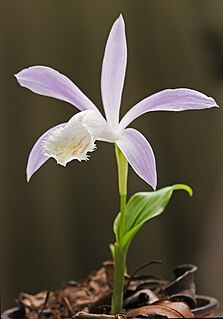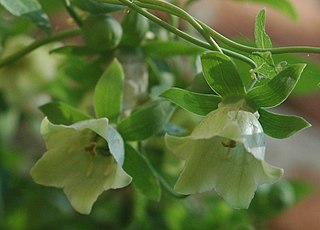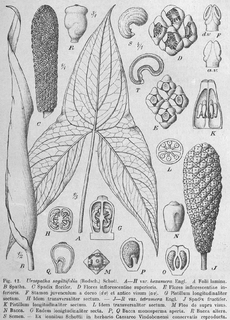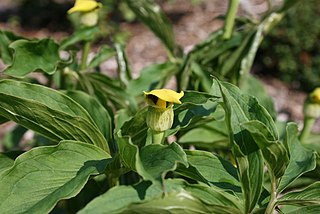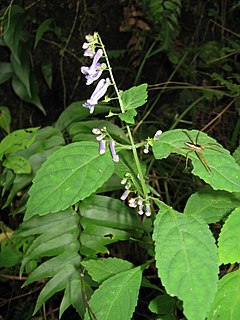| Remusatia | |
|---|---|
 | |
| Remusatia vivipara [1] | |
| Scientific classification | |
| Kingdom: | Plantae |
| Clade: | Angiosperms |
| Clade: | Monocots |
| Order: | Alismatales |
| Family: | Araceae |
| Tribe: | Colocasieae |
| Genus: | Remusatia Schott |
 | |
| Range of the genus Remusatia | |
| Synonyms [2] | |
GonatanthusKlotzsch | |
Remusatia is a genus of flowering plants in the family Araceae. It contains 4 known species, one of which was described in 1987. This species was initially placed in genus Gonatanthus called Gonatanthus ornatus. After the genus had been sunk into Remusatia its new name was Remusatia ornatus, but it was later changed to Remusatia hookeriana. [3]
A genus is a taxonomic rank used in the biological classification of living and fossil organisms, as well as viruses, in biology. In the hierarchy of biological classification, genus comes above species and below family. In binomial nomenclature, the genus name forms the first part of the binomial species name for each species within the genus.
Family is one of the eight major hierarchical taxonomic ranks in Linnaean taxonomy; it is classified between order and genus. A family may be divided into subfamilies, which are intermediate ranks between the ranks of family and genus. The official family names are Latin in origin; however, popular names are often used: for example, walnut trees and hickory trees belong to the family Juglandaceae, but that family is commonly referred to as being the "walnut family".

The Araceae are a family of monocotyledonous flowering plants in which flowers are borne on a type of inflorescence called a spadix. The spadix is usually accompanied by, and sometimes partially enclosed in, a spathe or leaf-like bract. Also known as the arum family, members are often colloquially known as aroids. This family of 114 genera and about 3750 known species is most diverse in the New World tropics, although also distributed in the Old World tropics and northern temperate regions.
The species of Remusatia are native to Asia, Africa, and Australia. [2] They are typically found in subtropical forests and are tuberous plants with heart shaped peltate leaves. A characteristic feature of Remusatia is its stolons that emerge from the tubers on which is produced bulbils that allow the plant to reproduce. The bulbils cling to animals which allows for them to be distributed and is likely the primary cause for their large distribution. Flowering of many Remusatias are often rare and bulbils serve as their primary means of reproduction. The spathes of Remusatia are yellow and the spadix are white with a fragrance except for Remusatia yunnanensis whose spathe is red. [4] [5]

Asia is Earth's largest and most populous continent, located primarily in the Eastern and Northern Hemispheres. It shares the continental landmass of Eurasia with the continent of Europe and the continental landmass of Afro-Eurasia with both Europe and Africa. Asia covers an area of 44,579,000 square kilometres (17,212,000 sq mi), about 30% of Earth's total land area and 8.7% of the Earth's total surface area. The continent, which has long been home to the majority of the human population, was the site of many of the first civilizations. Asia is notable for not only its overall large size and population, but also dense and large settlements, as well as vast barely populated regions. Its 4.5 billion people constitute roughly 60% of the world's population.

Africa is the world's second largest and second most-populous continent, being behind Asia in both categories. At about 30.3 million km2 including adjacent islands, it covers 6% of Earth's total surface area and 20% of its land area. With 1.2 billion people as of 2016, it accounts for about 16% of the world's human population. The continent is surrounded by the Mediterranean Sea to the north, the Isthmus of Suez and the Red Sea to the northeast, the Indian Ocean to the southeast and the Atlantic Ocean to the west. The continent includes Madagascar and various archipelagos. It contains 54 fully recognised sovereign states (countries), nine territories and two de facto independent states with limited or no recognition. The majority of the continent and its countries are in the Northern Hemisphere, with a substantial portion and number of countries in the Southern Hemisphere.

Australia, officially the Commonwealth of Australia, is a sovereign country comprising the mainland of the Australian continent, the island of Tasmania and numerous smaller islands. It is the largest country in Oceania and the world's sixth-largest country by total area. The neighbouring countries are Papua New Guinea, Indonesia and East Timor to the north; the Solomon Islands and Vanuatu to the north-east; and New Zealand to the south-east. The population of 25 million is highly urbanised and heavily concentrated on the eastern seaboard. Australia's capital is Canberra, and its largest city is Sydney. The country's other major metropolitan areas are Melbourne, Brisbane, Perth and Adelaide.
- Species [2] [6]
- Remusatia hookeriana Schott - Yunnan, Assam, Arunachal Pradesh, Bhutan, Nepal, Myanmar, Thailand, Himalayas of eastern + northern India
- Remusatia pumila (D.Don) H.Li & A.Hay - Tibet, Yunnan, Assam, Arunachal Pradesh, Bhutan, Nepal, Thailand, Himalayas of eastern + northern India
- Remusatia vivipara (Roxb.) Schott - central + western Africa from Tanzania and Ethiopia to Sierra Leone; Oman, Yemen, Taiwan, Tibet, Yunnan, Indian Subcontinent, Indochina, Java, Bali, Christmas Island, Queensland, Northern Territory of Australia
- Remusatia yunnanensis (H.Li & A.Hay) A.Hay in R.H.A.Govaerts & D.G.Frodin - Yunnan, Taiwan
